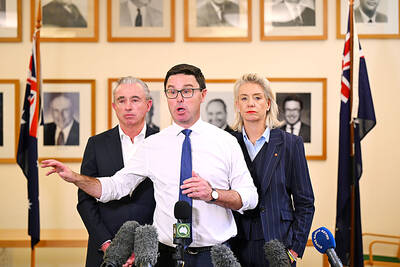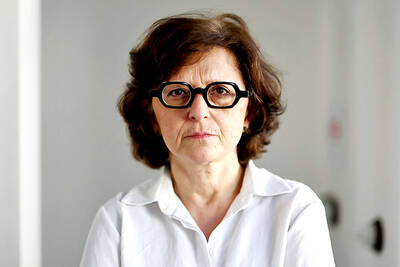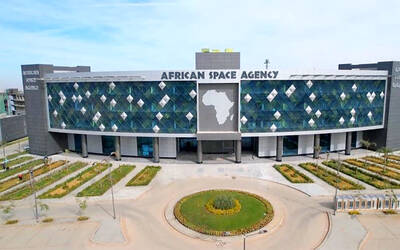It was never easy living among the Namib desert’s spectacular vistas, with ancient camel thorn trees providing sparse shade and huge red sand dunes reflecting the burning hot sun.
But signs that climate change may be worsening the already harsh conditions in this patch of desert have led to novel experiments and skillful improvisation under in one of the world’s hottest countries.
Scientists toil at the privately run Gobabeb research station — a center appropriately powered by solar panels — to come up with new ways of collecting water that could help local farmers.
Nearby uranium mines are meanwhile paying for the construction of a desalination plant to cover their needs.
Such projects are vital, with water demand expected to exceed ground water extraction capacity by 2015, posing a major risk in such a dry country.
Namibian Deputy Environmental Minister Leon Jooste said climate change could severely impact Namibia’s agriculture and Gobabeb’s experiments will help address the problem.
“Most agricultural activities of our country depend on rainfall,” Jooste said, adding that without it, “livestock has no grazing and crops cannot be harvested.”
Started in 1962, Gobabeb has gained an international reputation among scientists for its biodiversity and underground water supply research in the Namib.
One of its experiments involves harvesting morning fog from the nearby coast with screens. The fog condenses into water that is then sent through a pipe.
Namibia is the driest country in sub-Saharan Africa, with annual rainfall varying between 30mm in the desert to 500mm in the extreme northeastern Caprivi region.
Climate change may already be making the situation worse.
“Recent analysis of the country’s climate data, which stretch over 100 years, shows an observable increase in temperature of approximately one to 1.2 degrees Celsius,” Namibia’s Renewable Energy and Energy Efficiency Institute said in a report published last month. “In recent years, hot temperatures are getting hotter, hot days of above 35 degrees Celsius are becoming more frequent and the number of cold nights decreasing.”
Rainfall seasons are already starting later and ending earlier, affecting subsistence farmers who grow maize and millet.
“For the last few years we’ve had to plant these crops later — January, February — and harvest later as well — July instead of May — because it rains late,” said Bollen Masule, a Caprivi farmer.
The Namib Desert, considered one of the world’s oldest, stretches some 1,400km from the Orange River in the south to the Kunene River, which forms the border with Angola.
Concerns over water shortages extend beyond agriculture to include Namibia’s key uranium mining industry.
Not far from Gobabeb, a sign explains plans for a nearby uranium mine — one of 12 new uranium mines that have applied for government approval.
“We are constructing a water desalination plant at the coast to accommodate the water needs of those new mines,” Namibian Water Corporation head Vaino Shivute said.
The project is worth 1.2 billion Namibian dollars (US$160 million). It only benefits the mines, however, which must pay for it, not nearby coastal towns.

BACKLASH: The National Party quit its decades-long partnership with the Liberal Party after their election loss to center-left Labor, which won a historic third term Australia’s National Party has split from its conservative coalition partner of more than 60 years, the Liberal Party, citing policy differences over renewable energy and after a resounding loss at a national election this month. “Its time to have a break,” Nationals leader David Littleproud told reporters yesterday. The split shows the pressure on Australia’s conservative parties after Prime Minister Anthony Albanese’s center-left Labor party won a historic second term in the May 3 election, powered by a voter backlash against US President Donald Trump’s policies. Under the long-standing partnership in state and federal politics, the Liberal and National coalition had shared power

CONTROVERSY: During the performance of Israel’s entrant Yuval Raphael’s song ‘New Day Will Rise,’ loud whistles were heard and two people tried to get on stage Austria’s JJ yesterday won the Eurovision Song Contest, with his operatic song Wasted Love triumphing at the world’s biggest live music television event. After votes from national juries around Europe and viewers from across the continent and beyond, JJ gave Austria its first victory since bearded drag performer Conchita Wurst’s 2014 triumph. After the nail-biting drama as the votes were revealed running into yesterday morning, Austria finished with 436 points, ahead of Israel — whose participation drew protests — on 357 and Estonia on 356. “Thank you to you, Europe, for making my dreams come true,” 24-year-old countertenor JJ, whose

A documentary whose main subject, 25-year-old photojournalist Fatima Hassouna, was killed in an Israeli airstrike in Gaza weeks before it premiered at Cannes stunned viewers into silence at the festival on Thursday. As the cinema lights came back on, filmmaker Sepideh Farsi held up an image of the young Palestinian woman killed with younger siblings on April 16, and encouraged the audience to stand up and clap to pay tribute. “To kill a child, to kill a photographer is unacceptable,” Farsi said. “There are still children to save. It must be done fast,” the exiled Iranian filmmaker added. With Israel

Africa has established the continent’s first space agency to boost Earth observation and data sharing at a time when a more hostile global context is limiting the availability of climate and weather information. The African Space Agency opened its doors last month under the umbrella of the African Union and is headquartered in Cairo. The new organization, which is still being set up and hiring people in key positions, is to coordinate existing national space programs. It aims to improve the continent’s space infrastructure by launching satellites, setting up weather stations and making sure data can be shared across